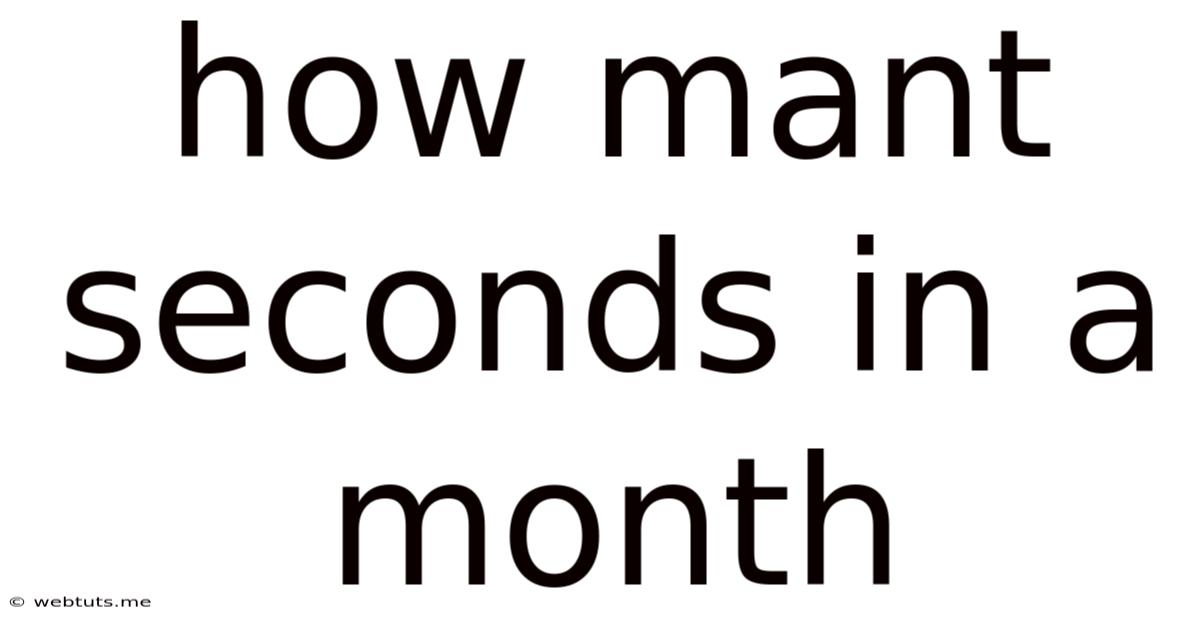How Mant Seconds In A Month
Webtuts
Apr 20, 2025 · 4 min read

Table of Contents
How Many Seconds are in a Month? A Deep Dive into Time Calculation
The seemingly simple question, "How many seconds are in a month?" reveals a fascinating complexity when we delve into the intricacies of timekeeping. There's no single definitive answer, as the length of a month varies considerably. This exploration will dissect the different ways to approach this question, offering a comprehensive understanding of time calculations and the challenges inherent in defining a "standard" month.
The Variable Nature of the Month
The primary reason for the lack of a simple answer is the inconsistent length of months. Unlike seconds, minutes, and hours, which are consistently defined, months vary significantly:
-
Calendar Months: These are the months we use in our everyday lives, ranging from 28 days (February in a common year) to 31 days. This variation immediately complicates any attempt to calculate a fixed number of seconds.
-
Lunar Months: Based on the lunar cycle, these months average approximately 29.53 days. This adds another layer of complexity, as even lunar months aren't uniformly long.
-
Synodic Months: This refers specifically to the time it takes the Moon to complete one cycle of phases (new moon to new moon), averaging roughly 29.53 days, but again, not perfectly consistent.
Calculating Seconds in Different Month Types
To address the question properly, we must consider each month type separately:
1. Seconds in a 28-Day Month (February in a Common Year):
- Days: 28 days
- Hours: 28 days * 24 hours/day = 672 hours
- Minutes: 672 hours * 60 minutes/hour = 40,320 minutes
- Seconds: 40,320 minutes * 60 seconds/minute = 2,419,200 seconds
2. Seconds in a 29-Day Month (February in a Leap Year):
- Days: 29 days
- Hours: 29 days * 24 hours/day = 696 hours
- Minutes: 696 hours * 60 minutes/hour = 41,760 minutes
- Seconds: 41,760 minutes * 60 seconds/minute = 2,505,600 seconds
3. Seconds in a 30-Day Month:
- Days: 30 days
- Hours: 30 days * 24 hours/day = 720 hours
- Minutes: 720 hours * 60 minutes/hour = 43,200 minutes
- Seconds: 43,200 minutes * 60 seconds/minute = 2,592,000 seconds
4. Seconds in a 31-Day Month:
- Days: 31 days
- Hours: 31 days * 24 hours/day = 744 hours
- Minutes: 744 hours * 60 minutes/hour = 44,640 minutes
- Seconds: 44,640 minutes * 60 seconds/minute = 2,678,400 seconds
5. Seconds in an Average Lunar Month:
- Days: Approximately 29.53 days
- Hours: 29.53 days * 24 hours/day ≈ 708.72 hours
- Minutes: 708.72 hours * 60 minutes/hour ≈ 42,523.2 minutes
- Seconds: 42,523.2 minutes * 60 seconds/minute ≈ 2,551,392 seconds
The Importance of Specificity
The calculations above highlight the crucial need for specifying which month you're referring to when asking about the number of seconds. Without this clarification, any answer is inherently imprecise.
Beyond Simple Calculations: Factors Affecting Time
While the basic calculations provide numerical answers, several factors influence the actual perception and measurement of time:
-
Leap Seconds: Occasionally, a "leap second" is added to Coordinated Universal Time (UTC) to account for slight variations in the Earth's rotation. This affects the total number of seconds in a given year, and consequently, the average number of seconds per month.
-
Time Zones: Different time zones across the globe further complicate the issue. A month's duration in seconds might vary slightly depending on the specific time zone considered.
-
Relativity: Einstein's theory of relativity dictates that time is relative and can be affected by factors such as gravity and velocity. While the effects are minuscule in everyday life, they theoretically affect the precise measurement of a month's duration in seconds.
Practical Applications and Context
Understanding the variability of month lengths is crucial in various fields:
-
Software Development: Accurate timekeeping is vital for applications that rely on scheduling, data logging, and other time-sensitive operations. Programmers need to account for the varying lengths of months to avoid errors.
-
Financial Calculations: Interest calculations, loan repayments, and other financial computations often require precise time calculations, making an understanding of the different month lengths essential.
-
Scientific Research: Researchers in fields like astronomy and meteorology frequently work with time series data, necessitating awareness of the discrepancies between different types of months.
-
Project Management: Scheduling projects and tasks accurately requires a clear understanding of time durations, including the lengths of months, to ensure efficient planning and execution.
Conclusion: No Single Answer, but a Deeper Understanding
There is no single, universally applicable answer to the question, "How many seconds are in a month?". The answer depends entirely on which month (February in a common year versus a leap year, or a 30-day versus a 31-day month) and even the specific definition of a month (calendar, lunar, synodic) one employs. The key takeaway is not a single number, but rather a deeper appreciation for the complexities of time measurement and the importance of specifying the relevant context when dealing with such calculations. This detailed exploration has hopefully clarified the variations and provided a thorough understanding of the different factors affecting the number of seconds within a month. By understanding these nuances, we can approach time-related calculations with greater accuracy and precision.
Latest Posts
Latest Posts
-
900 Feet Is How Many Miles
May 09, 2025
-
30 Ml Is Equal To How Many Tablespoons
May 09, 2025
-
How Many Weeks Has It Been Since July 29
May 09, 2025
-
How Many Days Until Sep 19
May 09, 2025
-
How Many Days Till Jan 31 2025
May 09, 2025
Related Post
Thank you for visiting our website which covers about How Mant Seconds In A Month . We hope the information provided has been useful to you. Feel free to contact us if you have any questions or need further assistance. See you next time and don't miss to bookmark.